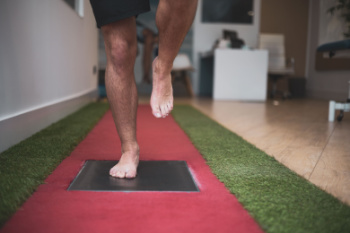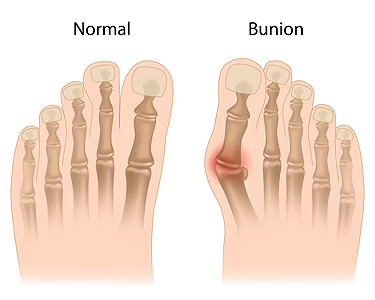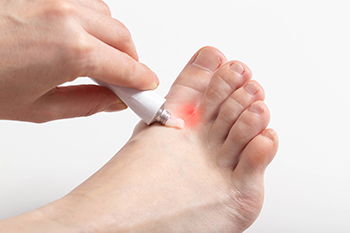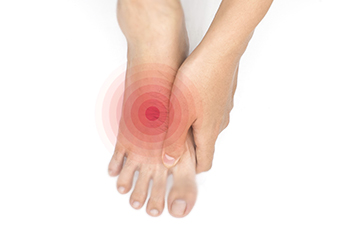Blog
Items filtered by date: August 2024
Foot Structure and Common Conditions

The foot is a complex structure essential for mobility and balance, consisting of various bones, ligaments, and joints. It includes 26 bones, categorized into three types, which are the tarsals, metatarsals, and phalanges. The tarsals form the rear part of the foot, including the heel and ankle bones. The metatarsals make up the middle part, while the phalanges are the toe bones. This intricate arrangement supports the body’s weight, absorbs shock, and allows for diverse movements. Common foot conditions such as flat feet, plantar fasciitis, and bunions can arise from structural abnormalities or excessive stress. Understanding the anatomy and function of the foot helps in diagnosing and managing these conditions effectively. If you have a foot condition that is causing you pain and discomfort, it is suggested that you consult a podiatrist who can diagnose the cause of your foot pain, and treat it accordingly.
If you have any concerns about your feet, contact David Lambarski, DPM from Northeast Foot Care. Our doctor can provide the care you need to keep you pain-free and on your feet.
Biomechanics in Podiatry
Podiatric biomechanics is a particular sector of specialty podiatry with licensed practitioners who are trained to diagnose and treat conditions affecting the foot, ankle and lower leg. Biomechanics deals with the forces that act against the body, causing an interference with the biological structures. It focuses on the movement of the ankle, the foot and the forces that interact with them.
A History of Biomechanics
- Biomechanics dates back to the BC era in Egypt where evidence of professional foot care has been recorded.
- In 1974, biomechanics gained a higher profile from the studies of Merton Root, who claimed that by changing or controlling the forces between the ankle and the foot, corrections or conditions could be implemented to gain strength and coordination in the area.
Modern technological improvements are based on past theories and therapeutic processes that provide a better understanding of podiatric concepts for biomechanics. Computers can provide accurate information about the forces and patterns of the feet and lower legs.
Understanding biomechanics of the feet can help improve and eliminate pain, stopping further stress to the foot.
If you have any questions please feel free to contact our offices located in Amsterdam and Clifton Park, NY . We offer the newest diagnostic and treatment technologies for all your foot and ankle needs.
Causes and Symptoms of Bunions

Bunion pain arises from a bony bump at the base of the big toe, often caused by genetic factors, improper footwear, or foot deformities. Wearing tight, high-heeled, or narrow shoes worsens the condition, pushing the toe out of alignment and increasing pain. Symptoms include swelling, redness, and difficulty moving the affected toe. To find relief, start by switching to well-fitting, comfortable shoes with ample room for the toes. Using orthotic devices or bunion pads can help cushion and realign the foot. Gentle foot exercises may improve flexibility. If you see signs of a bunion developing, it is suggested that you consult a podiatrist for effective treatment methods.
If you are suffering from bunions, contact David Lambarski, DPM of Northeast Foot Care. Our doctor can provide the care you need to keep you pain-free and on your feet.
What Is a Bunion?
A bunion is formed of swollen tissue or an enlargement of boney growth, usually located at the base joint of the toe that connects to the foot. The swelling occurs due to the bones in the big toe shifting inward, which impacts the other toes of the foot. This causes the area around the base of the big toe to become inflamed and painful.
Why Do Bunions Form?
Genetics – Susceptibility to bunions are often hereditary
Stress on the feet – Poorly fitted and uncomfortable footwear that places stress on feet, such as heels, can worsen existing bunions
How Are Bunions Diagnosed?
Doctors often perform two tests – blood tests and x-rays – when trying to diagnose bunions, especially in the early stages of development. Blood tests help determine if the foot pain is being caused by something else, such as arthritis, while x-rays provide a clear picture of your bone structure to your doctor.
How Are Bunions Treated?
- Refrain from wearing heels or similar shoes that cause discomfort
- Select wider shoes that can provide more comfort and reduce pain
- Anti-inflammatory and pain management drugs
- Orthotics or foot inserts
- Surgery
If you have any questions, please feel free to contact our offices located in Amsterdam and Clifton Park, NY . We offer the newest diagnostic and treatment technologies for all your foot care needs.
Fungal Foot Diseases
 Fungal diseases of the feet, including athlete's foot, or tinea pedis, are common infections caused by dermatophytes, fungi that thrive in warm, moist environments. These infections lead to symptoms like itching, redness, peeling skin, and sometimes blisters. Athlete's foot typically affects the spaces between the toes but can spread to other areas of the foot. These infections occur due to prolonged exposure to damp conditions, such as wearing sweaty socks or walking barefoot in communal areas like locker rooms and swimming pools. Individuals at higher risk include athletes, people with weakened immune systems, and those who frequently use public showers. Relief may come from keeping feet clean and dry, using antifungal creams or powders, and wearing breathable footwear. If you have persistent athlete’s foot, it is suggested that you schedule an appointment with a podiatrist for advanced treatment solutions.
Fungal diseases of the feet, including athlete's foot, or tinea pedis, are common infections caused by dermatophytes, fungi that thrive in warm, moist environments. These infections lead to symptoms like itching, redness, peeling skin, and sometimes blisters. Athlete's foot typically affects the spaces between the toes but can spread to other areas of the foot. These infections occur due to prolonged exposure to damp conditions, such as wearing sweaty socks or walking barefoot in communal areas like locker rooms and swimming pools. Individuals at higher risk include athletes, people with weakened immune systems, and those who frequently use public showers. Relief may come from keeping feet clean and dry, using antifungal creams or powders, and wearing breathable footwear. If you have persistent athlete’s foot, it is suggested that you schedule an appointment with a podiatrist for advanced treatment solutions.
Athlete’s foot is an inconvenient condition that can be easily reduced with the proper treatment. If you have any concerns about your feet and ankles, contact David Lambarski, DPM from Northeast Foot Care. Our doctor will treat your foot and ankle needs.
Athlete’s Foot: The Sole Story
Athlete's foot, also known as tinea pedis, can be an extremely contagious foot infection. It is commonly contracted in public changing areas and bathrooms, dormitory style living quarters, around locker rooms and public swimming pools, or anywhere your feet often come into contact with other people.
Solutions to Combat Athlete’s Foot
- Hydrate your feet by using lotion
- Exfoliate
- Buff off nails
- Use of anti-fungal products
- Examine your feet and visit your doctor if any suspicious blisters or cuts develop
Athlete’s foot can cause many irritating symptoms such as dry and flaking skin, itching, and redness. Some more severe symptoms can include bleeding and cracked skin, intense itching and burning, and even pain when walking. In the worst cases, Athlete’s foot can cause blistering as well. Speak to your podiatrist for a better understanding of the different causes of Athlete’s foot, as well as help in determining which treatment options are best for you.
If you have any questions please feel free to contact our offices located in Amsterdam and Clifton Park, NY . We offer the newest diagnostic and treatment technologies for all your foot and ankle needs.
Do You Suffer From Painful Feet?
Do You Suffer From Painful Feet?
Do You Suffer From Painful Feet?
Do You Suffer From Painful Feet?
Signs of Diabetic Foot Damage

Diabetes can lead to serious complications, including damage to the feet. One common sign is persistent pain, often described as sharp or tingling, which may indicate nerve damage, also known as neuropathy. Another symptom is a burning sensation, particularly in the feet, which can worsen at night. Swelling is also a concern, as it may signal poor circulation or fluid retention, both common in diabetic patients. Changes in skin color, ranging from pale to red or blue, can indicate reduced blood flow or infection. These signs should not be ignored, as diabetic foot damage can lead to ulcers, infections, and in severe cases, amputation. Regular foot inspections, maintaining healthy blood sugar levels, wearing proper footwear, and seeking immediate medical attention for any concerning symptoms are vital steps in managing and preventing diabetic foot complications. If you have diabetes, it is suggested that you are under the care of a podiatrist who can help you to manage this condition.
Diabetic foot care is important in preventing foot ailments such as ulcers. If you are suffering from diabetes or have any other concerns about your feet, contact David Lambarski, DPM from Northeast Foot Care. Our doctor can provide the care you need to keep you pain-free and on your feet.
Diabetic Foot Care
Diabetes affects millions of people every year. The condition can damage blood vessels in many parts of the body, especially the feet. Because of this, taking care of your feet is essential if you have diabetes, and having a podiatrist help monitor your foot health is highly recommended.
The Importance of Caring for Your Feet
- Routinely inspect your feet for bruises or sores.
- Wear socks that fit your feet comfortably.
- Wear comfortable shoes that provide adequate support.
Patients with diabetes should have their doctor monitor their blood levels, as blood sugar levels play such a huge role in diabetic care. Monitoring these levels on a regular basis is highly advised.
It is always best to inform your healthcare professional of any concerns you may have regarding your feet, especially for diabetic patients. Early treatment and routine foot examinations are keys to maintaining proper health, especially because severe complications can arise if proper treatment is not applied.
If you have any questions please feel free to contact our offices located in Amsterdam and Clifton Park, NY . We offer the newest diagnostic and treatment technologies for all your foot and ankle needs.

